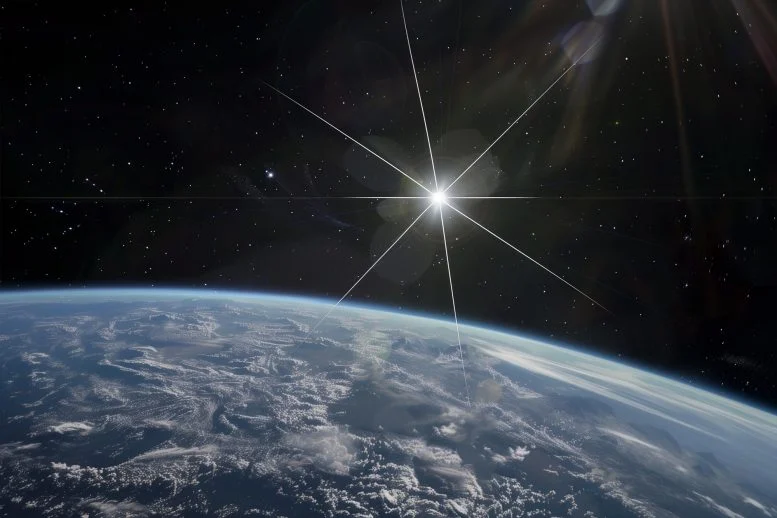
By Nathan Kahl and Tracy Mason, George Mason University November 20, 2024
Collected at: https://scitechdaily.com/nasas-groundbreaking-artificial-star-to-decode-dark-energy-mysteries/
The Landolt NASA Space Mission, hosted by George Mason University, will orbit an artificial star to refine telescope calibrations and astrophysical measurements. This project aims to advance the accuracy of scientific data concerning the universe’s expansion and celestial properties.
George Mason University will lead the $19.5 million Landolt NASA Space Mission, a groundbreaking project that will launch an artificial “star” into Earth’s orbit. This artificial star will enable scientists to calibrate telescopes and improve measurements of stellar brightness, from nearby stars to distant supernova explosions in remote galaxies. By achieving precise absolute flux calibration, the mission will tackle key astrophysical challenges, including understanding the speed and acceleration of the universe’s expansion.
“This mission marks another first for George Mason University, a milestone that proves our impact as a major public research university truly knows no bounds,” said George Mason University President Gregory Washington. “It’s an honor for George Mason to lead this unique team seeking to expand the boundaries of knowledge through College of Science associate professor Peter Plavchan’s collaboration with NASA, one of George Mason’s most prestigious research partners.”

Expanding Astrophysical Understanding Through Precision
Scientists already know the universe is expanding, and they measure this expansion by analyzing the brightness of stars and the photons they emit per second. However, according to Peter Plavchan, associate professor of physics and astronomy and the Landolt Mission’s principal investigator, more precise measurements are critical to unlocking the next breakthroughs in astrophysics.
Named for late astronomer Arlo Landolt, who put together widely used catalogs of stellar brightness throughout the 1970s through the 1990s, this mission will launch a light into the sky in 2029 with a known emission rate of photons, and the team will observe it next to real stars to make new stellar brightness catalogs. The satellite (artificial star) will have eight lasers shining at ground optical telescopes in order to calibrate them for observations. The effort will not make the artificial stars so bright as to see with the naked eye, but one can see it with a personal telescope at home.
Mission Details and Impact on Astronomical Measurements
“This mission is focused on measuring fundamental properties that are used daily in astronomical observations,” said Eliad Peretz, NASA Goddard mission and instrument scientist and Landolt’s deputy principal investigator. “It might impact and change the way we measure or understand the properties of stars, surface temperatures, and the habitability of exoplanets.”
The artificial star will orbit Earth 22,236 miles up, far enough away to look like a star to telescopes back on Earth. This orbit also allows it to move at the same speed of the Earth’s rotation, keeping it in place over the United States during its first year in space. “This is what is considered an infrastructure mission for NASA, supporting the science in a way that we’ve known we needed to do, but with a transformative change in how we do it,” Plavchan explained.
Collaboration and Infrastructure of the Mission
The payload, which is the size of the proverbial bread box, will be built in partnership with the National Institute of Standards and Technology (NIST), a world leader in measuring photon emissions. “This calibration under known laser wavelength and power will remove effects of atmosphere filtration of light and allow scientists to significantly improve measurements,” explained Peter Pachowicz, associate professor in Mason’s Department of Electrical and Computer Engineering, who is leading this component of the mission.
George Mason faculty and students from Mason’s College of Science and College of Engineering and Computing will work together with the NASA and NIST and nine other organizations for a first-of-its-kind project for a university in the Washington, D.C., area. Pachowicz added, “This is an incredibly exciting opportunity for George Mason and our students. Our team will design, build, and integrate the payload, which—because it’s going very high into geostationary orbit—must handle incredible challenges.”
With mission control based at George Mason on its Fairfax Campus, the team also includes Blue Canyon Technologies; California Institute of Technology; Lawrence Berkeley National Laboratory; Mississippi State University; Montreal Planetarium and iREx/University of Montreal; the University of Florida; the University of Hawaiʻi; the University of Minnesota, Duluth; and the University of Victoria.
With more accurate measurements, experts will use the improved data from the project to enhance understanding of stellar evolution, habitable zones or exoplanets in proximity to Earth, and refine dark energy parameters, setting a foundation for the next great leaps in scientific discovery. “When we look at a star with a telescope, no one can tell you today the rate of photons or brightness coming from it with the desired level of accuracy,” Plavchan, who is also the director of Mason’s Observatories in Fairfax, said. “We will now know exactly how many photons-per-second come out of this source to .25 percent accuracy.”
“Flux calibration is essential for astronomical research,” explained NIST’s Susana Deustua, a Physical Scientist in the NIST Remote Sensing Group. “We constantly ask: ‘How big? How bright? How far?’ and then ponder: ‘What is the universe made of? Are we alone?’ Accurate answers require precise measurements and excellent instrument characterization,” Deustua said.

Leave a Reply